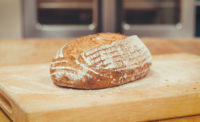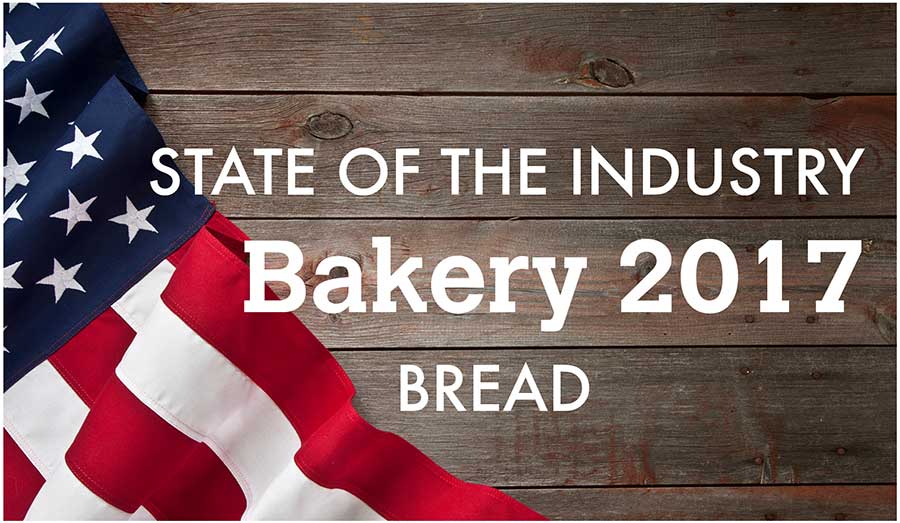State of the Industry 2017: Tradition anchors breads while innovation looks to the future
Traditional products anchor the category while a range of trends align with new directions for breads, bagels and English muffins.


courtesy of Ardent Mills

courtesy of Pepperidge Farm

courtesy of Bimbo Bakeries USA

courtesy of Ardent Mills

courtesy of Flowers Foods

courtesy of Bimbo Bakeries USA


courtesy of Bimbo Bakeries USA


courtesy of Bimbo Bakeries USA

Fresh Bread sales

Bagel sales

English Muffins sales














Bread is the largest category in the baking industry, and as such, faces continual challenges related to incremental growth. While legacy brands continue to perform well, the fresh bread, bagel and English muffin categories remained largely flat to slightly down over the past year.
Overview | Bread | Tortillas | Sweet Goods | Snack Cakes | Pizza | Desserts | Cookies | Buns & Rolls | Bars | Breakfast Products
Still, this is a segment responsible for over $10 billion in sales.
In the baking industry, breads are the big show. This is the category of Brownberry, Sara Lee, Thomas’, Nature’s Own and Pepperidge Farm. This is the category where legends are made.
And bread’s future legends will have a decidedly different look and feel than the classics.
Market data
The overall category of fresh bread and rolls was valued at $13.4 billion for the 52 weeks ending March 19, 2017, up 0.34 percent, per IRI, Chicago. The fresh bread segment within the category accounted for $9.1 billion, up 0.15 in dollar sales. The top performer was category leader Grupo Bimbo/Bimbo Bakeries USA, up 2.79 percent to $2.4 billion.
In bagels/bialys, dollar sales dropped by 3.02 percent to $834.4 million. Three of the top five brands in the category saw sales drops for the year. The top performer was United States Bakery/Franz, with a gain of 6.72 percent, hitting $20.6 million.
The English muffins category saw a slight increase of 0.25 percent to $737.1 million, per IRI. Bimbo, far and away the category leader with its iconic Thomas’ brand, saw sales increase by 0.81 percent to $607.5 million. In the better-for-you English muffin space, Food for Life Baking saw continued growth, this year up 7.76 in dollar sales to $14.4 million.
Looking back
Fresh bread, bagels and English muffins continue to see a strong level of new product development.
Bimbo has found success with its Sara Lee Artisano bread, formulated with a fine crumb and soft texture—and sliced thick for further differentiation. The product was officially launched on a national level in March 2016 and has built strong momentum since. In early 2017, IRI credited Sara Lee’s Artesano bread as one of the most-successful new product launches of 2016 in its 2016 “New Product Pacesetters” report, noting that it brought in $102.4 million in sales for the year.
Bimbo is also known for a healthy level of flavor experimentation within its Thomas’ brand and has brought several limited-time offer (LTO) Thomas’ flavors to market to date in 2017, including Pizza Flavored Bagels, Party Cake Mini Bagels, Bacon Buttermilk Pancake English Muffins, and S’mores Mini Bagels and English Muffins.
Flowers Foods took a better-for-you approach with its new Nature’s Own Life line extension, launched in March 2017. The line consists of six varieties: Wheat + Protein, 7 Sprouted Grains, Double Fiber Wheat, 100% Whole Grain Sugar Free, 40 Calories Honey Wheat and 40 Calories Wheat. All Nature’s Own breads are made without artificial preservatives, colors or flavors, and no high-fructose corn syrup.
“The biggest trends we presently see in retail bread products is the continued growth of the organic and non-GMO product categories,” says Walt Postelwait, president, Bellarise, Pasadena, CA. He expects continued expansion beyond mainstream pan breads to other categories, including bagels and English muffins. “In addition, we expect to see old, mainstream pan bread brands rejuvenated with the launch of new organic offerings under the same brand.”
Organic and non-GMO are hallmarks of clean-label products, an area of growing importance in bread.
“Clean label is very important in the bread category,” says Ken Skrzypiec, Eastern VP, sales and director of technical services, Brolite Products, Streamwood, IL. “As bread is sometimes seen as the ‘enemy’ of a diet, clean label allows bread to stay in an everyday diet.” He notes such breads can spotlight high fiber levels, and hearty grains and seeds.
Flowers Foods acquired organic brand Dave’s Killer Bread in 2015 and has since brought the brand to a national audience. A recent innovation was the launch of Dave’s Killer Bread Organic Bagels in Plain Awesome, Epic Everything, and Cinnamon Raisin Remix. All offer 11–12 grams of protein per bagel. Epic Everything also adds 560 mg of omega-3 per bagel, contributed by chia in the topping mix, a seed often grouped with ancient grains these days.
Skrzypiec notes that breads with diverse grains or seeds are increasing rapidly in sales and volume.
“According to our AB Mauri global ‘Window on the World’ annual report, ancient grains are at the height of their popularity,” says Rick Oleshak, vice president of marketing, AB Mauri North America, St. Louis. “Globally, chia (+168 percent) and teff (+155 percent) saw tremendous growth rates in use in new food and beverage launches from 2014 to 2016. Quinoa, bulgur, spelt, buckwheat, sorghum, amaranth and millet have also seen double-digit increases during the same timeframe. There are several reasons why these artisan grains are seeing increased popularity, from new nutritional values to unique flavors and textures.”
Pepperidge Farm, a Campbell Soup Co. business, looked toward the future of the category with a launch of a new bread line in April 2016, Harvest Blends, featuring: Seeded Grain, Ancient Grain and Sprouted Grain varieties.
Looking forward
The next wave of potential bread legends will continue along current trend trajectories, with increased emphasis on grain diversity, clean label, artisan quality and better-for-you appeal.
“We recently surveyed more than 1,600 consumers between the ages 18 and 70 to gauge their reaction to the appeal of 23 bread ideas,” says David Sheluga, director, consumer insights, Ardent Mills, Denver. The respondents were a 55-45 mix of women and men, nationally representative, living in all parts of the U.S. Findings included:
Ideas with the greatest appeal include “farm to table” bread. Local farms, local bakeries, family and history all help create unique and wholesome offerings.
“Five simple ingredients,” or similar claims, have widespread appeal. At the heart of clean eating is the desire for simple ingredients, and the fewer the better.
Specific claims like “pesticide free” and “save the bees” are great examples of layering today’s driving needs and creating a very strong multi-benefit idea. “Whole grain” combined with “pesticide free” means it’s mission-based, because it contributes to an animal welfare cause and “save the bees” research.
A flavor profile like sweet honey wheat hits many buttons. It promises sweetness, appealing to mainstream consumers. Natural sweeteners, like honey, are in. And honey sourced from local bee farms has even greater appeal, supporting local economy and adding trust from domestic farming, building cumulative appeal.
Ancient grains breads, with simple, wholesome grains like quinoa, amaranth and teff, have high appeal. Consumers what to understand what they eat and identify with foods that have been around for generations.
Abby Ceule, senior industry director, bakery, Corbion, Lenexa, KS, points to millennials as a key driver of emerging bread trends. “One of the biggest trends we’ve seen rise over the years from this consumer group is the demand for cleaner labels and more transparency around retail bread products. Consumers are paying more attention to what goes into the products they consume by looking at the labels and hoping to be able to make more educated purchase decisions around the retail bread products they buy.
“While perceptions do vary across the consumer audiences,” continues Ceule, “for most, clean labels and transparency mean products with the fewest ingredients that aren’t harmful or overly processed. Developing a solid formulation that offers a cleaner label with good taste, texture and tolerance is critical to ensuring consumer acceptance and, ultimately, market success in retail breads.”
Dave Kovacic, technical service, Bay State Milling, Quincy, MA, notes that it’s not uncommon now to see bread ingredient declarations listing only flour, water, yeast and salt—a quintessentially clean-label bread.
In-store bakery (ISB) breads often fit this ingredient approach, notes Michael Lengacher, commercialization leader, Innovative Bakery Resources, Tualatin, OR, making for a very “clean” ingredient listing. “This has, in part, led to fairly recent trends for ‘cleaner’ ingredient listings in the grocery isle. We’re seeing fewer preservatives in sliced breads, and more emphasis on cleaner, or natural, ingredients, such as ancient grains.”
More artisan breads have started to populate the ISB. Artisan sensibilities can bring strong visual and eating appeal to breads—but also improved functionality. “Many of our clients are removing some of their automation on their lines to lessen the stress on their doughs and create a better-textured product with better shelf life,” says Postelwait.
Ceule notes that ISBs are working closely with their suppliers to produce breads that have a longer shelf life and deliver on-trend freshness and taste.
Kovacic notes that the ISB is a growing home for new formats of artisan breads. “With changing demographics, loaf sizes are smaller, and artisan rolls, including take and bake, are available in smaller package counts,” he says. Many artisan-type breads can command a higher price point at retail, which can help improve margins. “Premium artisan breads, utilizing preferments, although not new, continue to gain more shelf space,” he says.
The artisan, premium price point is perhaps a natural fit for gluten-free breads—and this approach toward product positioning could help drive new levels of interest in gluten-free, which has started to plateau.
“What started out many years ago as an industry targeting those with celiac disease and other gluten intolerances has now grown to become a popular lifestyle choice for consumers who don’t necessarily have those types of dietary restrictions, but perceive gluten-free foods to be healthier and even more premium than traditional applications,” says Ceule. “The technology has improved for the development of gluten-free breads. The end products are getting closer to having the same eating qualities as bread with gluten, and the dough has more tolerance throughout the production process.”
The bread market continues to see more demand for greater variety in bread styles, flavor and aroma, provenance, and size or shape, says Oleshak. “Certainly, today’s consumers want to explore different tastes, which has led to the popularity of artisan grains, while at the same time, still enjoying breads in convenient, on-the-go formats. Also, there continues to be a strong correlation between the demand for cleaner-label items and greater transparency in product labeling with the increased desire by consumers to know more about the foods they are consuming.”
Postelwait notes that ancient grains like quinoa, amaranth, sorghum, buckwheat and flax can bring a sense of “authenticity” to breads. “They want to connect with the true origins of bread products. We see similar consumer desires in the craft beer market and other food sectors. In addition, we are seeing more use of vegetable powders and blue corn flours in many new bakery items.”
Smart ingredient selection can often yield multiple benefits to a bread. “Sprouted grains and multi-whole-grain breads with ancient grains are gaining popularity,” says Kovacic. “These breads also tend to contain blends of grains and seeds as inclusions or toppings. Both add visual interest, additional texture and taste, and can provide a boost of nutrition. Sprouted grains may help mitigate the bitterness of whole wheat.”
A clear key to growth of the bread category is strategic diversity of product selection. “Consumers are demanding a more-interesting bread slice today than in the past,” says Scott Dillingham, regional plant manager, Innovative Bakery Resources. “In addition to healthier, high-inclusion, grain-based breads, consumers are also demanding sweet and indulgent options that may include streusel toppings, or flavorful fruit and grain inclusions.” He notes that bakery capabilities for scoring, swirl over, enrobing, inclusions and unique topical applications allow bakeries to deliver on these new types of bread trends.
A greater diversity of breads continues to make its way to market, and the right combination of product characteristics could very well catapult a select few to legendary status some day in the not-too-distant future.
Overview | Bread | Tortillas | Sweet Goods | Snack Cakes | Pizza | Desserts | Cookies | Buns & Rolls | Bars | Breakfast Products
Looking for a reprint of this article?
From high-res PDFs to custom plaques, order your copy today!




















